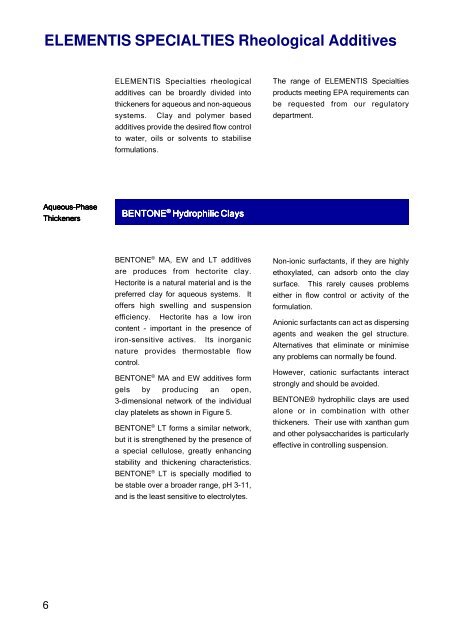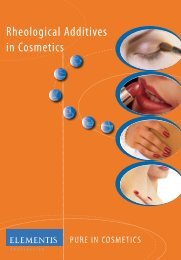Rheological Additives for Crop Protection - Elementis Specialties
Rheological Additives for Crop Protection - Elementis Specialties
Rheological Additives for Crop Protection - Elementis Specialties
You also want an ePaper? Increase the reach of your titles
YUMPU automatically turns print PDFs into web optimized ePapers that Google loves.
ELEMENTIS SPECIALTIES <strong>Rheological</strong> <strong>Additives</strong><br />
Aqueous-Phase<br />
Aqueous-Phase<br />
Thickeners<br />
Thickeners<br />
6<br />
ELEMENTIS <strong>Specialties</strong> rheological<br />
additives can be broardly divided into<br />
thickeners <strong>for</strong> aqueous and non-aqueous<br />
systems. Clay and polymer based<br />
additives provide the desired flow control<br />
to water, oils or solvents to stabilise<br />
<strong>for</strong>mulations.<br />
BENTONE BENTONE ® Hydrophilic<br />
Hydrophilic Hydrophilic Clays<br />
Clays<br />
BENTONE ® MA, EW and LT additives<br />
are produces from hectorite clay.<br />
Hectorite is a natural material and is the<br />
preferred clay <strong>for</strong> aqueous systems. It<br />
offers high swelling and suspension<br />
efficiency. Hectorite has a low iron<br />
content - important in the presence of<br />
iron-sensitive actives. Its inorganic<br />
nature provides thermostable flow<br />
control.<br />
BENTONE ® MA and EW additives <strong>for</strong>m<br />
gels by producing an open,<br />
3-dimensional network of the individual<br />
clay platelets as shown in Figure 5.<br />
BENTONE ® LT <strong>for</strong>ms a similar network,<br />
but it is strengthened by the presence of<br />
a special cellulose, greatly enhancing<br />
stability and thickening characteristics.<br />
BENTONE ® LT is specially modified to<br />
be stable over a broader range, pH 3-11,<br />
and is the least sensitive to electrolytes.<br />
The range of ELEMENTIS <strong>Specialties</strong><br />
products meeting EPA requirements can<br />
be requested from our regulatory<br />
department.<br />
Non-ionic surfactants, if they are highly<br />
ethoxylated, can adsorb onto the clay<br />
surface. This rarely causes problems<br />
either in flow control or activity of the<br />
<strong>for</strong>mulation.<br />
Anionic surfactants can act as dispersing<br />
agents and weaken the gel structure.<br />
Alternatives that eliminate or minimise<br />
any problems can normally be found.<br />
However, cationic surfactants interact<br />
strongly and should be avoided.<br />
BENTONE® hydrophilic clays are used<br />
alone or in combination with other<br />
thickeners. Their use with xanthan gum<br />
and other polysaccharides is particularly<br />
effective in controlling suspension.







